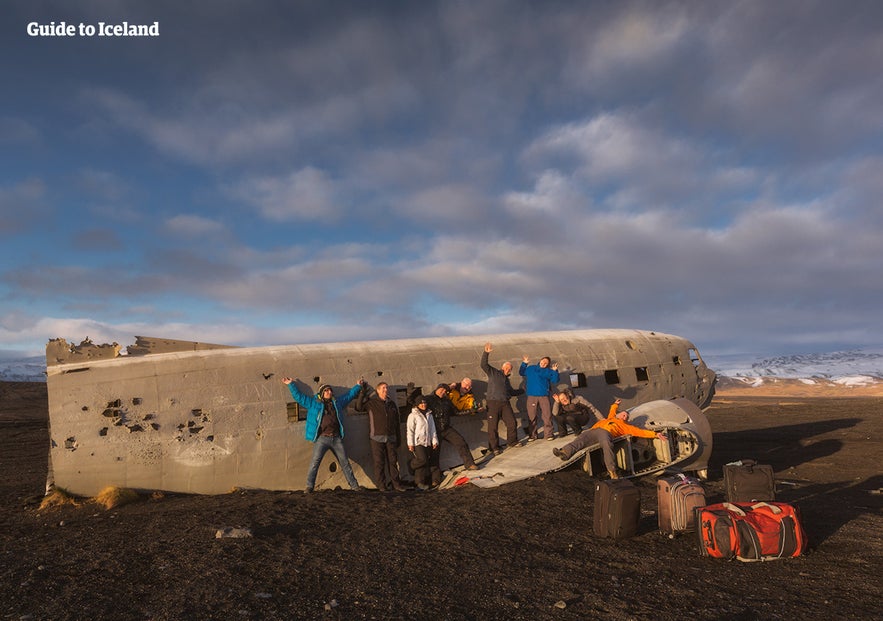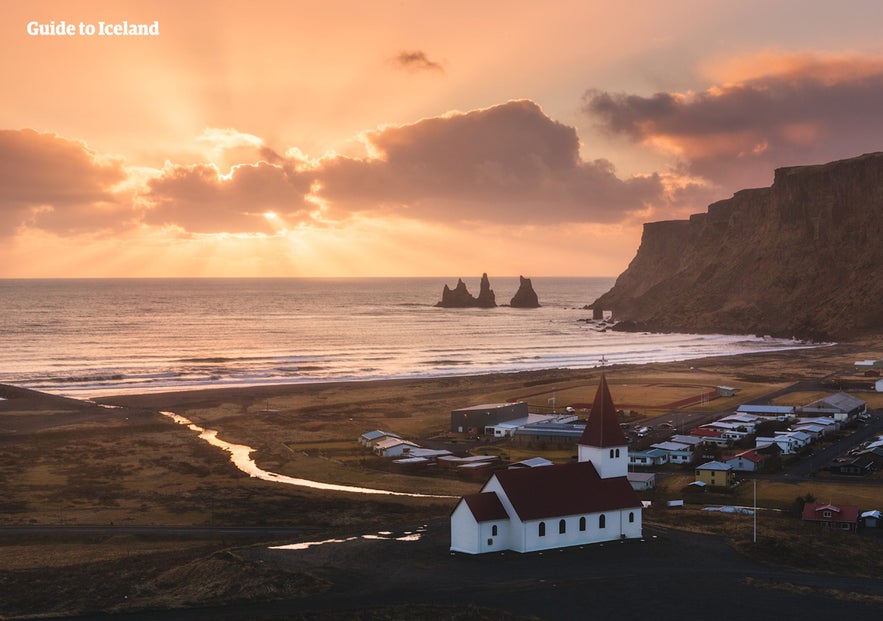
Islands sydkyst er en af de mest populære dele af landet for rejsende. Sydisland er omgivet af utallige naturlige vidundere, herunder brusende vandfald, vulkaner, gletsjere og sorte sandstrande.
Der er et stort udvalg af udflugter til og på Islands sydkyst, som tager dig med til alle de bedste steder på denne strækning.
Derfor kan du stole på vores indhold
Guide to Iceland er den mest pålidelige rejseplatform i Island, der hjælper millioner af besøgende hvert år. Alt vores indhold er skrevet og gennemgået af lokale eksperter, der kender Island ud og ind. Du kan stole på, at vi giver dig præcise, opdaterede og pålidelige rejsetips.
Den utrolige islandske sydkyst strækker sig fra Reykjavík-området i vest til den storslåede gletsjerlagune Jökulsárlón i øst. Det er muligt at tage en tur til Den Gyldne Cirkel, før man tager sydpå. Dette er et andet populært område for besøgende på Island. Her kan du se nationalparken Þingvellir, det geotermiske område Geysir, et vulkankrater kaldet Kerið og ét af Islands største vandfald; Gulfoss.
Hvis du vil udforske denne smukke region, anbefaler vi, at du booker et hotel i Sydisland, som du kan bruge som base for at rejse rundt i området.
Højdepunkter på Islands sydkyst
Sydkysten byder på en række naturlige vidundere, som tiltrækker tusindvis af besøgende hver dag.
Hele området er geologisk set meget ungt og blev dannet under den sidste istid af lavastrømmene fra de mange vulkaner i området. Lavlandet er omgivet af vulkansk aktive bjerge, især Eyjafjallajökull og Hekla. Hvis du stopper ved Hveragerði, kan du besøge udstillingen Quake 2008, hvor du kan se splittelsen mellem den nordamerikanske og den eurasiske tektoniske plade.
Kulturen i den sydlige del af landet er rig og mangfoldig. De fleste byer har amatørgrupper som laver teater, digtoplæsning og korsang. Fællesskabet er en stor del af islændingenes liv og en af de vigtigste ting, der hjælper dem med at komme igennem vintermånederne. Den sydlige del var engang hjemsted for det gamle bispesæde Skálholt. Islands mest berømte saga, Njals saga, foregår også i denne region.
Når man kører på sydkystruten fra Reykjavík, er den første store attraktion de to store vandfald Seljalandsfoss og Skógafoss. Disse vandfald ligger under den berygtede subglaciale vulkan Eyjafjallajökull. På klare dage kan man se Vestmanna-øerne på den anden side af havet fra disse smukke kaskader. Mindre end én kilometer fra Seljalandsfoss ligger den skjulte perle, Gljúfrabúi-vandfaldet.
Skógar, som er hjemsted for Skogafoss-vandfaldet, har et meget interessant museum, som fortæller om noget af landets historie og kultur. Én af Islands mest berømte vandrestier, Fímmvörðuháls, går gennem området og er en tur værd, hvis man har tid.
Lidt længere nede ad ruten ligger gletsjeren Mýrdalsjökull, som dækker en af Islands mest eksplosive vulkaner, Katla. Mange gletsjervandringer foregår her på gletsjertungen Sólheimajökull.
På trods af at dette landskab er meget yngre, er det også blevet formet af vulkanudbrud. Store områder med sort sand strækker sig fra højlandet til havet og er en del af flere gletsjersletter, der oversvømmes under et vulkanudbrud. En af disse sletter, Sólheimasandur, er hjemsted for et nedstyrtet DC-3-flyvrag.

Dernæst kommer Dyrhólaey-klipperne, som er hjemsted for mange havfugle. Ude i havet står en enorm klippebue af samme navn, som man kan beundre fra mange vinkler.
Ved siden af landsbyen Vík ligger den berømte sorte sandstrand Reynisfjara, hvor man kan se basaltsøjler og klippeformationerne Reynisdrangar. Disse søjler siges at være to trolde, der blev forstenet af solens lys. Det er et stop på de fleste ture på sydkysten, og du kan også booke udflugter til Vik for at besøge stedet.
Selvom området er smukt, er det berygtet for sine farlige sneaker-bølger. Selv på tilsyneladende rolige og stille dage bør besøgende holde sig på afstand af vandkanten. Der er ingen landmasser mellem Reynisfjara-stranden og det antarktiske kontinent, så man kan godt forestille sig, hvordan bølgerne kan tage fart.

Efter at have passeret Vík krydser du Skeiðarársandurs gletsjerslette, før du kommer ind i Vatnajökull Nationalpark. Her kan du se Vatnajökull-gletsjeren, Islands største gletsjer. Mange isgrotteudflugter finder sted i Vatnajökull i vintermånederne.
Tag videre til det dramatiske Skaftafell Naturreservat i selve nationalparken. Her kan du nyde mangfoldige landskaber og terræner. Området bliver betragtet som en nationalpark i sig selv, fordi det er så smukt.
Til sidst nærmer du dig den berømte Jökulsarlon-gletsjerlagune, en dyb sø, der fyldes med isbjerge, når Breiðamerkurjökull-gletsjeren langsomt nedbrydes. Her er der masser af muligheder for bådture, som tager dig rundt i lagunen og helt tæt på isbjergene. I kort afstand fra Jökulsárlón finder du Diamantstranden, hvor blå isbjerge skyller ind over den sorte sandstrand, samt en anden gletsjerlagune kaldet Fjallsárlón.
Geografi, natur og dyreliv
Sydkysten er den lettest tilgængelige del af landets sydlige region, som ligger langs Ringvejen (Rute 1), der omkranser Island. Området består af forskellige landskaber; sumpområder, bugter, dyrkede græsgange, flodmundinger og sorte sandørkener.
Under jorden hviler et stort lavafelt, kendt som Þjórsárhraun. Det når flere hundrede meter ud i havet og udgør en beskyttende faktor for lavlandet, når havets bølger slår ind over det. Resultatet er at sydkysten er usædvanligt fri for de dybe fjorde, som så tydeligt kendetegner resten af Islands kystlinje.
I modsætning til de fleste tidlige islandske bosættelser var kun få af samfundene i syd baseret på fiskeri. Den eneste by med en betydelig havn i syd er Þorlákshöfn, hvor færgen til Vestmanna-øerne afgår. Der er en del landbrug her med gårde i bjergene, men på grund af istidens oversvømmelser er der langt mellem dem.
Tilgengæld er der masser af varme kilder i området. Den mest berømte er Den Blå Lagune, som ligger tæt på Keflavik lufthavn. Lagunen blev dannet som følge af overløb fra et nærliggende kraftværk.
Der er dog masser af naturlige geotermiske varme kilder på mere afsidesliggende steder, hvor man kan undgå menneskemængderne og få en mere naturlig oplevelse. Nogle af de steder, som rejsende anbefaler, er Seljavallalaug, som ligger tæt på Skogar, og Reykjadalur, dampens dal, som ligger tæt på Hveragerði.
Den sydlige region har et livligt fugleliv på alle årstider. Ferskvandsfugle bygger rede i marskområderne og omkring flodmundingerne, mens havfugle flokkes omkring klipperne ved Reynisdrangar og Dyrhólaey.
Du kan måske få øje på nordatlantiske søpapegøjer, der bygger rede på klipperne fra maj til august. Om sommeren er der to til tre gange så mange fjordterner som islændinge, så du vil helt sikkert få øje på nogle af dem på din rejse. Nogle arter bliver her gennem hele den hårde islandske vinter, bl.a. norddykkeren, lomvien og forskellige måge- og andearter.
Man kan ofte se sæler langs kysten, især omkring Jökulsárlón-gletsjerlagunen og Diamantstranden. Som overalt i Island bør man altid holde øje med havet, da der lever hvaler og delfiner langs hele kystlinjen.
Når det gælder sport, er ridning populært, ligesom fiskeri, vandreture, snorkling, sightseeing og river rafting.













